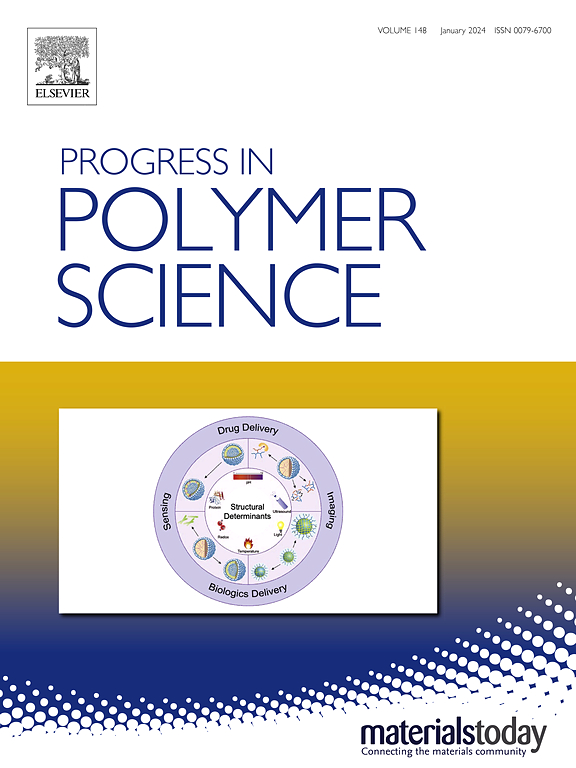基于聚合物和超分子化学的多模防伪材料
IF 26.1
1区 化学
Q1 POLYMER SCIENCE
引用次数: 0
摘要
高分子科学和超分子化学的结合已经成为开发动态和响应材料的一个有前途的探索平台。非共价超分子化学与大分子共价化学的协同作用在传感和防伪领域开辟了先进的应用。这种超分子相互作用包括氢键、主-客体相互作用、金属配位和静电相互作用、供体-受体和π-π堆叠。由于许多超分子自组装系统会导致所涉及的超分子单元的吸收或发射行为发生变化,因此聚合物与这些超分子基元的结合为传感、信息存储和防伪应用提供了强大的平台。考虑到伪造手法的不断变化,动态防伪技术需要具有不同颜色和时间维度的多模式防伪系统。由于国家、政府、供应商和客户对多模防伪材料的高度需求,使用可逆的、动态的超分子结构与聚合物相结合,提供良好的可加工性和材料性能,是非常有前途的。本文综述了嵌入超分子相互作用的高分子材料作为新型多模态防伪材料的设计与应用。本文章由计算机程序翻译,如有差异,请以英文原文为准。


Multimode anticounterfeiting materials based on polymers and supramolecular chemistry
The combination of polymer science and supramolecular chemistry has emerged as a promising exploration platform in developing dynamic and responsive materials. The synergy of non-covalent supramolecular chemistry with macromolecular covalent chemistry has opened up advanced applications in the sensing and anticounterfeiting fields. Such supramolecular interactions include hydrogen bonding, host-guest interactions, metal coordination and electrostatic interactions, donor-acceptor, and π-π stacking. Since many supramolecular self-assembling systems lead to a change in absorption or emission behavior of the involved supramolecular units, the combination of polymers with such supramolecular motifs provides a powerful platform for sensing, information storage, and anticounterfeiting applications. Considering that counterfeiting tactics continue to change, the need for multimode anticounterfeiting systems with diverse color and time dimensions as dynamic anticounterfeiting technology is indispensable. Due to the high need for multimode anticounterfeiting materials for nations, governments, suppliers, and customers, it is highly promising to use reversible, dynamic supramolecular structures in combination with polymers that provide good processability and materials properties. This review article provides an overview of the design and application of polymer materials with embedded supramolecular interactions as innovative multimodal anticounterfeiting materials.
求助全文
通过发布文献求助,成功后即可免费获取论文全文。
去求助
来源期刊

Progress in Polymer Science
化学-高分子科学
CiteScore
48.70
自引率
1.10%
发文量
54
审稿时长
38 days
期刊介绍:
Progress in Polymer Science is a journal that publishes state-of-the-art overview articles in the field of polymer science and engineering. These articles are written by internationally recognized authorities in the discipline, making it a valuable resource for staying up-to-date with the latest developments in this rapidly growing field.
The journal serves as a link between original articles, innovations published in patents, and the most current knowledge of technology. It covers a wide range of topics within the traditional fields of polymer science, including chemistry, physics, and engineering involving polymers. Additionally, it explores interdisciplinary developing fields such as functional and specialty polymers, biomaterials, polymers in drug delivery, polymers in electronic applications, composites, conducting polymers, liquid crystalline materials, and the interphases between polymers and ceramics. The journal also highlights new fabrication techniques that are making significant contributions to the field.
The subject areas covered by Progress in Polymer Science include biomaterials, materials chemistry, organic chemistry, polymers and plastics, surfaces, coatings and films, and nanotechnology. The journal is indexed and abstracted in various databases, including Materials Science Citation Index, Chemical Abstracts, Engineering Index, Current Contents, FIZ Karlsruhe, Scopus, and INSPEC.
 求助内容:
求助内容: 应助结果提醒方式:
应助结果提醒方式:


